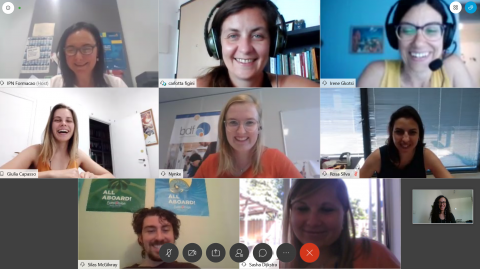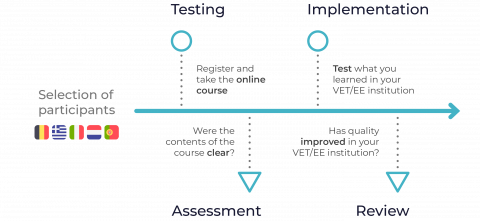3.5 - Implementation
Abstract
As a Quality Manager of your VET organization, you need to monitor the activities and the
achievements of your team and/or your organization. But it’s quite difficult to do this, as you need
to constantly check deadlines, the results of a given activity and its quality. And, with the results of
your quality checks, you need to provide feedback to your team and/or your boss in order to
guarantee the quality standards of your VET organization.
Why is this important for you as a QM?
- To be constantly up to date with the items you need to check, their deadlines and ready to support your colleagues with clarifications;
- To understand if your team has achieved the goals that they had to reach;
- To understand if your team has achieved the goals that they had to do and in how much time;
- To understand if your team has achieved its goals, on time and according to the quality standards;
- To identify gaps and areas of improvements by comparing what your team as achieved with the quality standards;
- To create confidence in the quality of the work of your team, as you may actually need to implement remedial action to avoid the risks of not achieving the technical and quality requirements;
- To check consistency in what you have promised during the design phase and monitoring what has actually happened in the middle from a technical and quality point of view;
- To create a sense of ownership within your company, as it’s a tool through which you can communicate with your team.
How should I implement the action?
When it comes to implementation there is no one-size-fits-all for solutions, but here below we
suggest to you some steps to take:
- First of all, you need to be aware of the goals you need to achieve, the quality standards and the deadlines of the activities that your team is developing;
- Do you have in your organization a Quality Standard Advisory Committee that you need to involve or do you need to engage external stakeholders through focus groups, surveys and interviews?
- Once you have all these aspects clearly in mind, then you need to develop a working document, namely your implementation plan, that can support your dynamic implementation;
- The implementation plan supports you in mapping out the different steps, where each step is assigned to a specific person or team with a definite timeline; in the implementation plan, you need to break your quality strategy down into identifiable steps, assigning each step (if necessary) to one or more people and deadlines;
- As a working document you may actually use online systems (such as Google drive + Asana) or just a piece of paper and an agenda or projectmanager.com, etc. What’s important is that people can work on it in a collaborative way;
- You may actually need a dynamic GANTT chart to check consistency and time schedule;
How should I know if I have made an impact thus increasing the quality of the VET provision and to which extent? (Indicators also linked with the EQAVET if any):
- You may actually see that your team is reaching its objectives and remedial actions are taking place successfully;
- The time you spend implementing activities decreases;
- Your company is increasing the quality standards of its deliveries;
- Your stay on track easily with your team, as everyone knows the quality standards to achieve and how to do it.
Links & further readings (includes also third-party resources- videos, etc.):
- Bero LA, Grilli R, Grimshaw JM, Harvey E, Oxman AD, Thomson MA, 2016. Quality Standards, Process and Methods Guide.
- Smartsheets. 2020. From Strategy to Execution: How to Create a Sustainable, Repeatable Implementation Plan. [https://www.smartsheet.com/implementation-plan]. Last access 27.03.2020.
- Malsam William. December 2019. Implementation Plan: How to Create and Execute One.[https://www.projectmanager.com/blog/implementation-plan]. Last access 27.03.2020.



